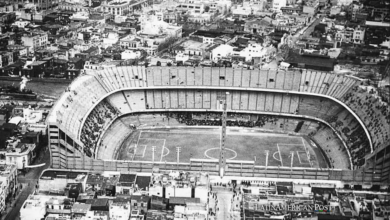How Soccer’s Hispanic Influence Is Transforming U.S. Sports Culture

The arrival of Argentine soccer legend Lionel Messi to Inter Miami in 2023, coupled with the growing influence of Hispanic audiences, has revolutionized the sports landscape in the United States. This shift is reshaping how Americans engage with soccer, a sport once considered niche.
When Lionel Messi, one of the greatest soccer players of all time, joined Inter Miami in 2023, it wasn’t just a significant moment for Major League Soccer (MLS) but for American sports culture. The “Messi Effect” is no mere media buzzword. His arrival has brought new fans to the game, dramatically increasing TV viewership and drawing attention to soccer in ways no player before him has managed.
According to a recent Nielsen report, Messi’s debut match in the U.S. resulted in a staggering 300% increase in viewership. Hispanic audiences, who have long supported soccer, were a driving force behind this surge, but Messi’s influence has transcended this group. His presence on the field attracts a broader and more diverse audience, including younger fans and non-Hispanic viewers, expanding soccer’s reach beyond its traditional base.
The first match Messi played for Inter Miami skyrocketed viewership for channels like Univision and TUDN and boosted overall TV watching time by 32% on a Saturday without a live soccer broadcast. Nielsen’s data shows that soccer is no longer just a sport dominated by Hispanic audiences; it has become a mainstream phenomenon, with Messi at the heart of this transformation.
Soccer’s Roots in America: A Legacy of Pioneers
Though Messi’s arrival has brought unparalleled attention to soccer in the U.S., it’s essential to acknowledge the foundation laid by soccer pioneers long before him. The history of soccer in America is rich with trailblazing figures, notably Brazilian legend Pelé, whose arrival at the New York Cosmos in the 1970s sparked the country’s first significant soccer boom.
Pelé’s decision to play for the Cosmos in 1975 after a storied career with Brazil’s national team and Santos FC was monumental. At the time, soccer struggled to find a foothold in the American sports market, dominated by football, baseball, and basketball. Yet Pelé’s star power made headlines and filled stadiums, drawing attention to the North American Soccer League (NASL). Pelé’s three seasons with the Cosmos helped ignite interest in soccer, and though the NASL eventually folded, his influence left an indelible mark on American sports.
Other soccer legends followed in Pelé’s footsteps, further cementing the sport’s growing presence in the U.S. Johan Cruyff, Franz Beckenbauer, and Giorgio Chinaglia were just a few stars who helped put American soccer on the map during the late 1970s and early 1980s. While soccer’s growth was slow, its contributions laid the groundwork for MLS, which was founded in 1993 and has since become one of the fastest-growing sports leagues in the U.S.
The arrival of international stars like David Beckham in the early 2000s also boosted MLS’s popularity. Beckham’s signing with the LA Galaxy in 2007 echoed Pelé’s impact decades earlier, bringing global attention to the league and helping to attract other top international talent. Beckham, who would later become co-owner of Inter Miami, laid the foundation for the kind of transformational impact Messi is now having on U.S. soccer.
The Hispanic Influence
While international stars have brought global attention to soccer in the U.S., the Hispanic community has long been the backbone of the sport’s growth in the country. According to Nielsen’s “Fanáticos” report, the Hispanic population accounted for 53% of the viewership of the 2024 Copa América final in the U.S. Their enthusiasm for the sport continues to be a key driver of soccer’s expanding influence.
Soccer’s popularity among Hispanic audiences is unsurprising, as it has deep roots in Latin American culture. For decades, Mexican and Central American immigrants have brought their passion for the game with them, supporting teams from their home countries as well as those in the U.S. This passion has translated into high viewership numbers for international tournaments like the Copa América and the UEFA Champions League, where Hispanic viewers made up 40% of the audience for the 2023 final between Real Madrid and Borussia Dortmund.
Hispanic fans have also been instrumental in the success of MLS and Liga MX matches. The final of Liga MX’s Clausura in 2023 saw a 74% increase in viewership compared to 2016, with much of that growth attributed to Hispanic fans. Their loyalty to soccer has fostered a vibrant culture in the U.S. that has only grown stronger with the arrival of stars like Messi.
As the Hispanic population continues to grow—now accounting for over 65 million people and responsible for 71% of the U.S. population growth from 2022 to 2023—their economic and cultural influence is becoming increasingly evident. In 2023, Hispanic consumers had a purchasing power of $3.4 trillion, further highlighting their importance in shaping the future of soccer in the U.S.
Soccer’s Increasing Mainstream Appeal
While the Hispanic community’s love for soccer has been a critical factor in the sport’s growth in the U.S., Messi’s influence has brought the game into the mainstream. His presence on the field attracts younger fans and a more diverse audience, expanding soccer’s reach beyond its traditional base of Hispanic viewers. According to Nielsen, the percentage of non-Hispanic viewers watching the Copa América has steadily increased, rising from 27% to 47% in recent years.
Messi’s arrival in Miami coincided with a broader cultural shift in the U.S. The growing interest in global sports, increased access to soccer through streaming services, and the country’s changing demographics have all contributed to soccer’s rising popularity. The 2024 Copa América final, which attracted over 12 million viewers in the U.S., is now the most-watched soccer event in American history.
Soccer’s newfound mainstream appeal is also evident in the rise of women’s soccer. The U.S. Women’s National Team’s (USWNT) victory over Brazil in the 2024 Olympics drew a record-breaking 9 million viewers, with a significant portion of the audience being Hispanic. The success of the women’s team, combined with the growing viewership of women’s soccer leagues, highlights soccer’s expanding influence in American sports culture.
Moreover, soccer’s increasing presence in popular media and marketing reflects its growing cultural significance. Major brands are investing in soccer-related content, recognizing the sport’s broad appeal and its ability to connect with younger, diverse audiences. From TV commercials to social media campaigns, soccer is becoming vital to American sports and entertainment.
A New Era for Soccer in the U.S.
As soccer continues to grow in popularity, the U.S. is entering a new era for the sport. The rise of soccer in the country is not just about big-name players like Messi, Pelé, or Beckham; it’s about the convergence of culture, demographics, and a changing sports landscape increasingly embracing the global game.
For Latin Americans, soccer has always been more than just a game—it’s a part of their identity. As the Hispanic population continues to grow in the U.S., their love for soccer is transforming the American sports landscape. Soccer is no longer a niche sport but a mainstream phenomenon, capturing the attention of millions of Americans, both Hispanic and non-Hispanic alike.
This transformation also reshaped how soccer was viewed in the U.S. Once dismissed as a minor sport, soccer is now a serious contender in the crowded American sports market, standing alongside football, basketball, and baseball. With the 2026 FIFA World Cup set to be hosted by the U.S., Mexico, and Canada, the stage is set for soccer to reach even greater heights in North America.
In the coming years, the combination of international stars, the passionate support of Hispanic fans, and the growing mainstream interest in the sport will continue to drive soccer’s expansion in the U.S. As Messi and other stars help to elevate the profile of soccer, the sport’s future in America looks brighter than ever.
Also read: Capoeira: From Brazil’s Slaves to the World Stage
Soccer’s rise in the U.S. is a story of cultural convergence, driven by the passion of Hispanic fans and the influence of international stars like Lionel Messi. From Pelé’s groundbreaking arrival in the 1970s to Messi’s transformative impact today, soccer has evolved from a niche sport into a major force in American culture. As the sport continues to grow, it is clear that soccer’s future in the U.S. will be shaped by a diverse and passionate fan base that transcends borders and unites people across cultures.





